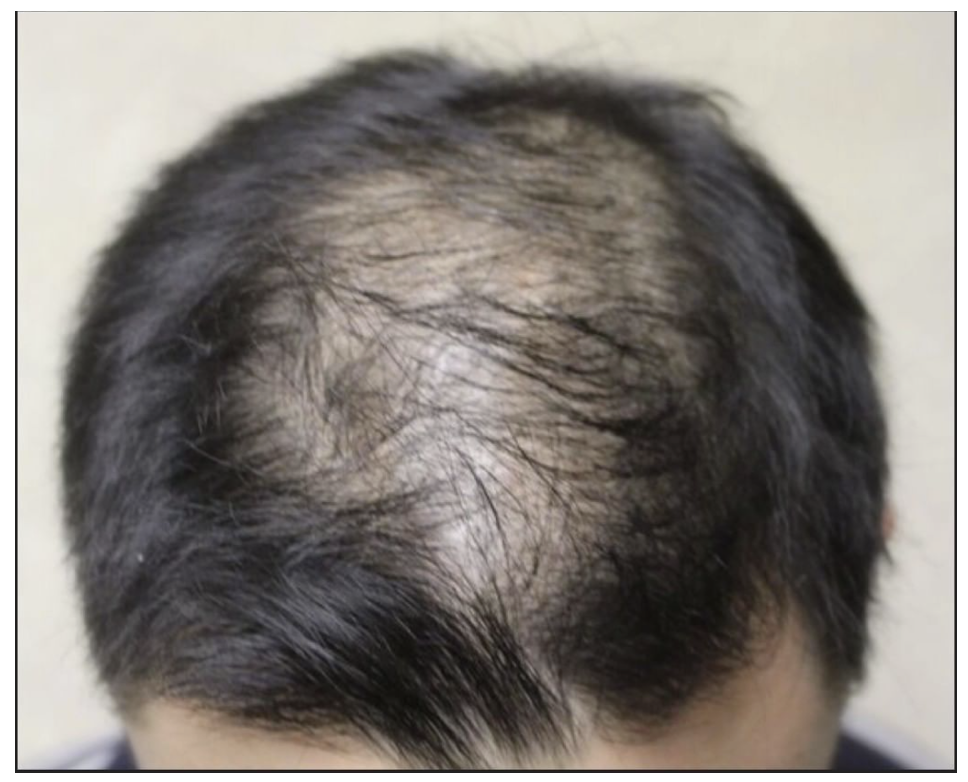The Female Pattern of Male Pattern Balding: Lessons from 84 Patients
“Female Pattern” of Male Balding Found in 4 % of 2140 Males
Most males with male balding develop their hair loss in a pattern that fits well with the Hamilton Norwood scale. Hair loss starts in the temples or crown and then expands to involve the entire frontal and mid scalp zones.
However, not all males develop balding in this typical way. Some males develop hair loss that diffusely involves the frontal, mid scalp and crown (the so called diffuse pattern alopecia or “DPA). Some males develop a form of male pattern hair loss that involves the entire scalp (so called diffuse unpatterned alopecia or “DUPA”). Some males develop a pattern that closely resembles female pattern hair loss.
36 year old male with a female pattern of male balding. Note the frontal hairline is retained and hair loss occurs in the mid-scalp zone behind the hairline.
Female Pattern of Male Balding
The female pattern of male balding differs from the classic form in that the frontal hairline is quite well preserved. Hair loss happens more in the mid scalp and follows better the Sinclair Scale than the Hamilton Norwood scale.
Kerkemeyer K et al, 2021
Kerkemeyer and colleagues from Australia set out to determine just how common the female pattern form of male balding actually is and whether there are any particular associations with this form that are worth paying closer attention to.
The authors identified a total of 2140 males with balding that were seen at their center over the period Nov 2017 to March 2020. 84 males with a female pattern of male balding. That equates to a total of 3.9 % of males having this pattern.
Of the 84 males, the average age of onset was 25.5 (with a range 11 to 47). Interestingly, European patients comprised 51 % of the group, South and Central Asian (eg, Indian) patients comprised 30 %, Southeast Asian (eg, Vietnamese) comprised 5 %, Northeast Asian (eg, Chinese) comprised 4 %. North African and Middle Eastern patients formed about 10 % and patients with Sub-Saharan African descent comprised 2 %. The authors point out that overall about 40 % of patients in this study with the female pattern were of Asian descent. This is approximately double the typical proportion of Asian patients in Melbourne Australia. Thus the authors hypothesized that Asian patients may be disproportionately affected by the female pattern of male pattern hair loss.
Of the 84 males with a female pattern of male balding 83 % had a family history. 19 % had low testosterone (normal 10-35 nmol/L) and 11 % had low free testosterone (normal 225-725 nmol/L.) 29% had low vitamin D levels (25 OHD less than 50 nmol/L).
Conclusion
This is an interesting study and one of the largest of its kind to specifically address the “female pattern” of male balding. The pattern was found to be present in 4 % males. Another key point of this study is the observation that this form of hair loss may disproportionately affect those of Asian descent. There were no control groups to really confidently say there are any increased risks of hormonal (low androgen issues). In fact, low testosterone is common in males and these numbers the authors present certainly could be quite typical of what we would expect in other males. I’m not overly convinced there are any clear blood test abnormalities in these patients compared to males with other patterns of hair loss but of course larger studies could settle this issue.
REFERENCES
Kerkemeyer K et al. Female pattern hair loss in men: A distinct clinical variant of androgenetic alopecia. J Am Acad Dermatol. 2021 Jul;85(1):260-262.
This article was written by Dr. Jeff Donovan, a Canadian and US board certified dermatologist specializing exclusively in hair loss.

